Except for a few early pieces bearing the geometric swastika symbol, the coins of Apollonia Pontika all feature the gorgon or Apollo on one side. An anchor, a crayfish, and usually the letter "A" is on the other side of all Apollonian coins.
 |
Apollonia Pontika was founded in 610 BC by Ionian Greeks from Miletus and named after Apollo. A 30' high 13 ton bronze statue of Apollo by the sculptor Kalamis guarded the harbor. When Roman legions under Marcus Lucullus sacked Apollonia in 72 BC the statue was taken to Rome but lost in antiquity. The city was renamed Sozopol ("Salvation") in the 4th century AD when it accepted Christianity and still exists today in Bulgaria, a hamlet of 4500 people with a yearly "Apollonia" arts festival.
The usual Apollonia Pontika coins encountered are the gorgon type drachm and the facing head diobol. The diobol type is described by some as "facing Apollo" and by others as "gorgon". Why is there no agreement as to what is being depicted?
The drachms of Apollonia Pontika are dated by SNG Black Sea to the later 5th century BC through the 4th century. I see the drachms as having four styles: the early, "wild" style with monstrous face surrounded by S-shaped snakes; a more human style with true hair rather than pellets, still surrounded by the snakes; a still more human version with ringlets for hair and (usually?) no snakes; and a version with unruly hair and no ringlets which is not pictured on this page..
Usually the coins are photographed so the anchor looks upside down and the alpha looks upright. I recall someone on-line suggesting that the ancients would have depicted the anchor as they saw it, hanging "upside down" from the side of a boat.
In the examples in SNG Black Sea the first two categories are described as drachms and weigh 3.14g - 3.32g (with one straggler at 2.88g) and the second two are described as "reduced drachms" and weigh 2.71 - 2.81g.
The "technical" obverse can be either the gorgon or the anchor. The gorgon drachms of Apollonia are dated to the later 5th and 4th century BC.
![[coin image]](a1.jpg)
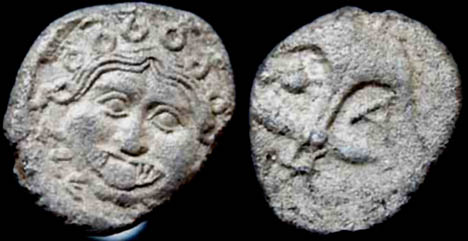
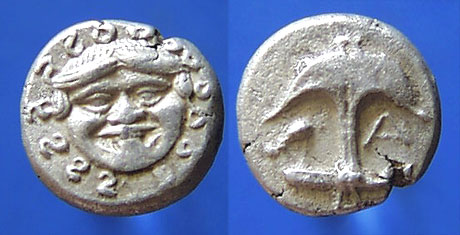 Three examples with humanized faces. There is real hair and snakes border the gorgoneion. The "A" is present on the reverse. 3.2, 3.05g and 3.18g respectively.
Three examples with humanized faces. There is real hair and snakes border the gorgoneion. The "A" is present on the reverse. 3.2, 3.05g and 3.18g respectively.
Later, we shall see a mule or forgery in the style of the third example.
The first coin has an interesting style. Ancient Auction House has sold at least one additional example from this die.
On the second coin three of the circle of snakes have merged with the cheek and become whiskers. A very unusual depiction and worth further study. I haven't been able to find any published examples with this depiction. Two other examples of this die pair were auctioned on eBay by Ancient Auction House (closing Aug-11-02 and Nov-19-02.)
The third example looks a great deal like Dewing 1275 but is not a die match. Ancient Auction House auctioned three other coins matching this die pair: (ending Oct-10-02, 3.21g; ending Oct-6-02, 3.35g; and ending Nov-28-02, 3.34g.)
![[coin image]](1301.jpg)
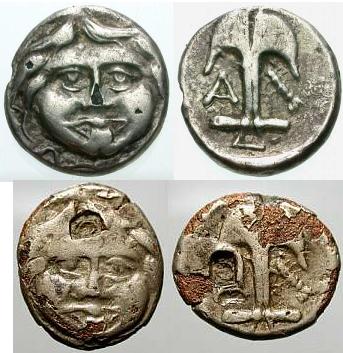 1.99 and 1.97g |
Celtic imitations of Apollonian diobols are known, for example Numismatik Lanz auction 106 lot 13 and auction 109 lot 57, but those specimens are quite light: 1.02g and 1.17g. Neither of those specimens had a protruding tongue. I have found no other examples of drachm imitations.
The examples on the right are also crude. These are "fourrés", bronze coins with silver plating made in ancient times by counterfeiters. Until I saw the imitation above I assumed it was the work of a remarkably unskilled ancient forger. I now believe the style is too different and believe this is a forgery of the imitation. The weights, about 2g, provide another link.
The two deep D-shaped punches on the lower coin the work of a merchant or coin checker who thought the coin looked odd and chose to test it. However, the coin has a lot of wear and must have circulated for some time before it was tested.
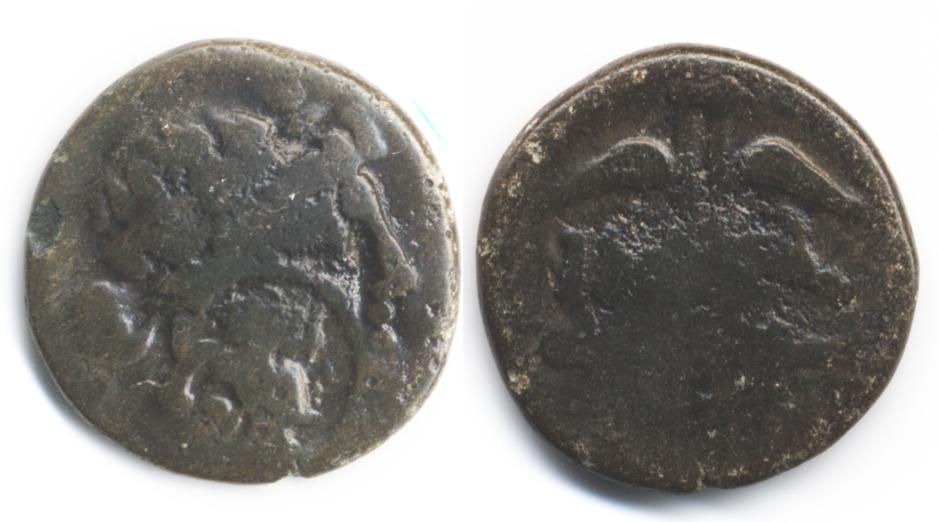 AE19, 4.5g |
These Apollo laureate r. bronzes are dated to the mid 4th - 3rd century B.C. Unlike most Greek AE, we know the denominations: dichalka and trichalka. Some dichalka have a written denomination on the reverse, ΔΙΧΑΛΚΙΗ or Δ-Ι. Others have two pellets. The trichalka examples in SNG Black Sea have three Χs.
Other bronzes of Apollonia feature Apollo sitting and standing. SNG Black Sea has five examples but there are none in SNG Stancomb or Lindgren. I suspect they are rare. The denominations of these are not known. This example has a star countermark similar to SNG Black Sea 188. This coin lacks the Apollonia 'A' in the anchor. The 'A' would have been directly opposite the countermark and was probably flattened.
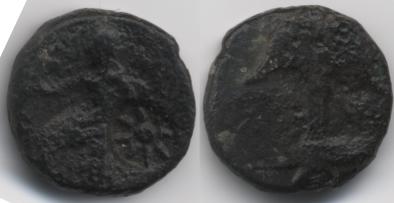 AE15, 4.36g
AE15, 4.36g
![[coin image]](4355.jpg) Now we come to the diobols. This example shows a calm face and spikes coming out of the head. This is Apollo, facing. The spikes here are exceptional. Other examples show much smaller decorations, which I take to be a facing view of the laurel seen when Apollo is depicted facing right or left. It is possible the spikes were purposefully exaggerated to resemble the sun's rays. This example weights 1.0g, which is much too light... the examples in SNG Black Sea range from 1.14 to 1.31g, with most at the high end of the spectrum.
Now we come to the diobols. This example shows a calm face and spikes coming out of the head. This is Apollo, facing. The spikes here are exceptional. Other examples show much smaller decorations, which I take to be a facing view of the laurel seen when Apollo is depicted facing right or left. It is possible the spikes were purposefully exaggerated to resemble the sun's rays. This example weights 1.0g, which is much too light... the examples in SNG Black Sea range from 1.14 to 1.31g, with most at the high end of the spectrum.
![[coin image]](s1657.jpg) This example weights a more respectable 1.2g. The decoration on the hair is unusual. It doesn't resemble rays or any kind of wreath. It looks a bit like the hair is turning into snakes, which would be highly unusual for a coin of this period.
This example weights a more respectable 1.2g. The decoration on the hair is unusual. It doesn't resemble rays or any kind of wreath. It looks a bit like the hair is turning into snakes, which would be highly unusual for a coin of this period.
Examples not pictured on this site are the swastika drachm, obol, and hemiobol; the right and left facing Apollo tetradrachms; the rare 3/4 and right facing Apollo diobols, the Apollo hemiobol, and the Apollo seated and standing AEs.
For more examples, including tetradrachms, see Wildwind.com's Apollonia Pontika thumbnail page.
![[coin image]](apontika.gif) 'Wild' style drachm, 3.3g |
When assembling the coins for this page I looked for 'interesting' coins. I like coins that have an element of mystery. I choose the title coin for the strange design in the hair. Did an ancient celator try to show snakes coming out of the hair? Or did I get caught by a poorly styled forgery? It is no comfort that the crayfish on the reverse is also poorly done or mis-struck.
This drachm is the first Apollonia Pontika coin I ever bought. An earlier version of this page featured it proudly, but it's authenticity has been brought into question. It may be part of the 1999 bad-Drachm hoard, a huge hoard (thousands of coins, 60+ dies) yet to be published. A coin that is clearly fake is less troubling to me than a coin which is merely doubtful.
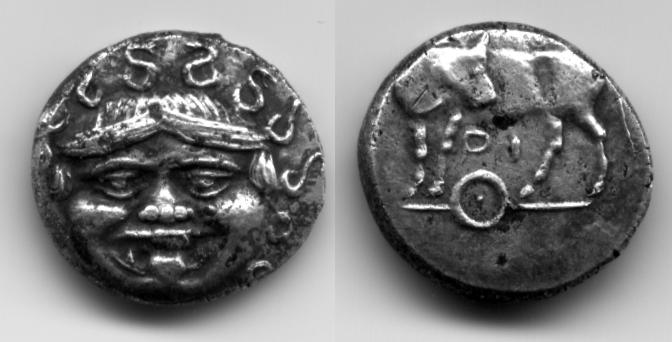 |
Thanks to the following dealers for selling these coins: Ancient Auction House, AncientCaesar, Ancient Treasures, Silenos, The Time Machine, WCNC, and Donald Zauche (among others.)
For more information on Apollonia Pontika see the Historia Numorum entry for Apollonia Pontika.
For more information on the Gorgon in Greek art and myth I recommend the book Medusa: Solving the Mystery of the Gorgon by Stephen R. Wilk.
For more information on Sozopol see the Sozopol travel guide. [bulgariancoast.com]
Numismatic references:
Sylloge Nummorum Graecorum The British Museum, I The Black Sea (SNG Black Sea) British Museum Press, 1993.
Principal Coins of the Greeks (based on the work of Barclay V. Head) British Museum Press, 1932.
Classical Deception by Wayne Sayles, 2001.